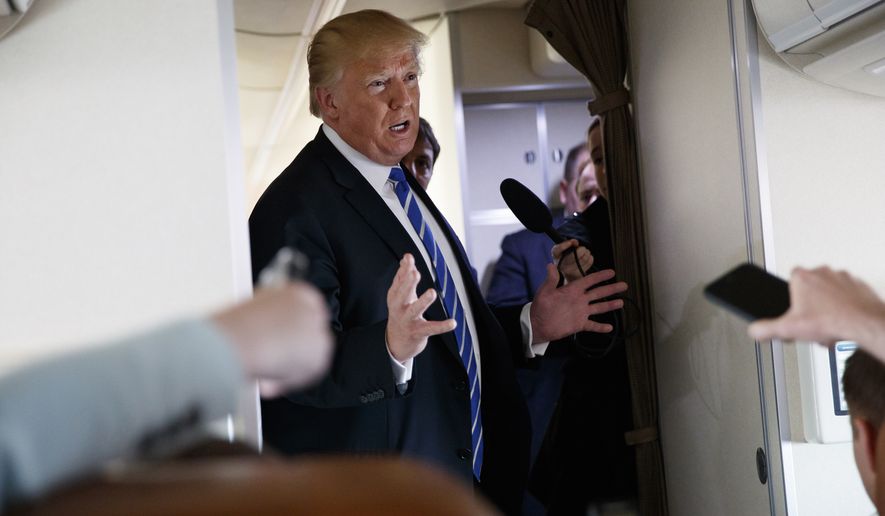Escalating his trade feud with China, President Trump ordered his administration Thursday night to consider adding another $100 billion worth of tariffs on Chinese products.
Mr. Trump said he is taking the action because China is imposing retaliatory tariffs on U.S. goods instead of fixing its unfair trade practices.
“Rather than remedy its misconduct, China has chosen to harm our farmers and manufacturers,” Mr. Trump said in a statement.
In light of China’s “unfair retaliation,” the president said, he has instructed U.S. Trade Representative Robert Lighthizer to “consider whether $100 billion of additional tariffs would be appropriate” and to identify Chinese products that could be taxed.
The escalating tariffs are raising concerns, especially in the U.S. agricultural sector. China announced this week that it intends to hit soybeans and other farm products imported from America.
The president said he has also instructed Agriculture Secretary Sonny Perdue to “use his broad authority to implement a plan to protect our farmers and agricultural interests.” He didn’t specify what actions they might be.
SEE ALSO: U.S.-China trade war fears send stock market into wild swings
Last fall, Mr. Perdue discussed the need for the government to develop a “contingency plan” for U.S. farmers and ranchers if the administration pulled out of the North American Free Trade Agreement with Canada and Mexico. He later said he was simply “thinking out loud” and offered no specifics.
U.S. and Chinese officials have been expressing optimism that a full-blown trade war can be averted through negotiations. Mr. Trump echoed that sentiment in his statement Thursday.
“Notwithstanding these actions, the United States is still prepared to have discussions in further support of our commitment to achieving free, fair, and reciprocal trade and to protect the technology and intellectual property of American companies and American people,” he said.
The administration announced tariffs last month against imported steel and aluminum and then unveiled a more targeted action aimed at preventing what Mr. Trump has called China’s theft of U.S. intellectual property.
“Trade barriers must be taken down to enhance economic growth in America and around the world,” the president said. “I am committed to enabling American companies and workers to compete on a level playing field around the world, and I will never allow unfair trade practices to undermine American interests.”
Mr. Lighthizer said the latest potential U.S. tariffs under Section 301 of the Trade Act of 1974 would also target China’s “unfair acts related to technology transfer, intellectual property and innovation.”
“President Trump is proposing an appropriate response to China’s recent threat of new tariffs,” Mr. Lighthizer said. “After a detailed investigation, USTR found overwhelming evidence that China’s unreasonable actions are harming the U.S. economy. In the light of such evidence, the appropriate response from China should be to change its behavior, as China’s government has pledged to do many times.”
Instead, he said, “China has chosen to respond thus far with threats to impose unjustified tariffs on billions of dollars in U.S. exports, including our agricultural products.
“Such measures would undoubtedly cause further harm to American workers, farmers, and businesses,” Mr. Lighthizer said. “Under these circumstances, the president is right to ask for additional appropriate action to obtain the elimination of the unfair acts, policies, and practices identified in USTR’s report.”
He said any proposed tariffs, as with earlier tariffs, would be subject to a public comment period before taking effect.
Senators from major soybean-producing states are increasingly alarmed at China’s vow to impose tariffs on U.S. soy exports. They say the international feud could hurt farmers and ranchers.
Republican Sen. Chuck Grassley of Iowa, whose state was the second-biggest producer of soybean exports in 2016, said he warned the president in February about the consequences of imposing tariffs.
“The administration knew that if it imposed tariffs on Chinese goods, China would retaliate against U.S. agriculture,” Mr. Grassley said in a statement. “Today shows that’s exactly what happened.”
The tariff announcements from Washington and Beijing have spooked financial markets, which sustained heavy losses in recent weeks before rebounding somewhat in the past few days.
At a forum on the economy in West Virginia earlier Thursday, Mr. Trump said he was obligated to get tough with China’s unfair trade practices as the U.S. trade deficit with Beijing has climbed to nearly $500 billion. Taking on China’s trade policies also was a central theme of Mr. Trump’s election campaign.
“For many years, no president wanted to go against China, economically,” Mr. Trump said. “And we’re going to do it.”
He reiterated that Chinese President Xi Jinping is a friend, but they are representing competing interests.
“In many respects, I think we’re going to have a fantastic relationship, long term, with China,” Mr. Trump said. “But we have to get this straightened out. We have to have some balance. And that goes for other countries, and it goes for other places.”
The president made the latest move after top U.S. and Chinese trade officials attempted to lower the rhetoric and negotiate a deal that could avert a full-blown trade war.
China announced Wednesday that it would impose a 25 percent tariff on about $50 billion of U.S. goods, including soybeans, automobiles and aircraft. It was Beijing’s response to a U.S. list of proposed tariffs released a day earlier on about $50 billion in Chinese goods.
Mr. Trump’s new chief economic adviser, Larry Kudlow, and other top White House officials have been downplaying the possibility of a trade war this week, saying any tariffs wouldn’t take effect for two months.
“I think we’re going to come to agreements,” Mr. Kudlow said Wednesday on Fox News. “I believe that the Chinese will back down and will play ball.”
• Dave Boyer can be reached at dboyer@washingtontimes.com.




Please read our comment policy before commenting.